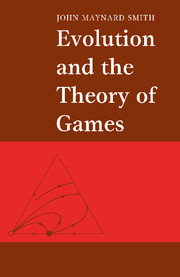Book contents
- Frontmatter
- Contents
- Preface
- 1 Introduction
- 2 The basic model
- 3 The war of attrition
- 4 Games with genetic models
- 5 Learning the ESS
- 6 Mixed strategies – I. A classification of mechanisms
- 7 Mixed strategies – II. Examples
- 8 Asymmetric games – I. Ownership
- 9 Asymmetric games – II. A classification, and some illustrative examples
- 10 Asymmetric games – III. Sex and generation games
- 11 Life history strategies and the size game
- 12 Honesty, bargaining and commitment
- 13 The evolution of cooperation
- 14 Postscript
- Appendixes
- Explanation of main terms
- References
- Subject index
- Author index
6 - Mixed strategies – I. A classification of mechanisms
Published online by Cambridge University Press: 05 June 2012
- Frontmatter
- Contents
- Preface
- 1 Introduction
- 2 The basic model
- 3 The war of attrition
- 4 Games with genetic models
- 5 Learning the ESS
- 6 Mixed strategies – I. A classification of mechanisms
- 7 Mixed strategies – II. Examples
- 8 Asymmetric games – I. Ownership
- 9 Asymmetric games – II. A classification, and some illustrative examples
- 10 Asymmetric games – III. Sex and generation games
- 11 Life history strategies and the size game
- 12 Honesty, bargaining and commitment
- 13 The evolution of cooperation
- 14 Postscript
- Appendixes
- Explanation of main terms
- References
- Subject index
- Author index
Summary
One of the clearest predictions of evolutionary game theory is that, in symmetric games, mixed ESS's are often to be expected whenever the potential costs of a contest are large compared to the advantages of winning. Is this expectation borne out? Equally important, what must we know about any particular case before it can reasonably be interpreted as a mixed ESS? These questions are by no means easy to answer, in particular because there are a number of different ways in which the processes of genetic evolution and individual learning can interact in producing stable mixed strategies.
In this chapter, I discuss, with the aid of concrete examples, some of the different ways in which a population may come to show variable behaviour. This discussion leads up to a classification of the mechanisms which underlie such behaviour; the classification is given in Table 10 on p. 78.
The first distinction which must be made is between a mixed strategy, in which the payoffs to the different actions are equal, and a pure strategy of the form ‘In situation 1, do A; in situation 2, do B’, in which some individuals are forced to make the best of a bad job. The distinction is best explained by an example. Rohwer (1977) has shown that in winter flocks of the Harris sparrow, individuals vary in the colour of their plumage from dark to pale, and that this variation is correlated with aggressiveness and dominance rank within flocks, the darker birds being more dominant.
- Type
- Chapter
- Information
- Evolution and the Theory of Games , pp. 68 - 80Publisher: Cambridge University PressPrint publication year: 1982



